AMD Unveils Ryzen Mobile 7040U Series with Zen 4c: Smaller Cores, Bigger Efficiency
by Gavin Bonshor & Ryan Smith on November 2, 2023 9:00 AM EST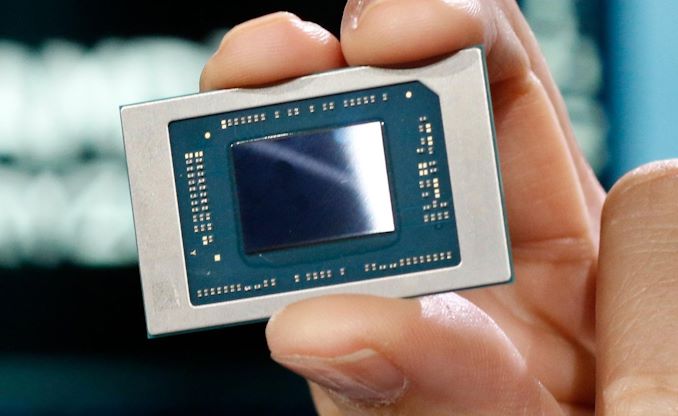
In May, AMD unveiled their Ryzen 7040U series of CPUs designed for thin and light notebooks, which they codenamed 'Phoenix.' Initially, AMD announced four Zen 4-based CPUs for the ultra-portable notebook market, with the Ryzen 7 7840U (8C/16T) and Ryzen 5 7640U (6C/12T) both leading the charge with AMD's integrated Ryzen AI, which is AMD's first-generation NPU for on-chip AI and inferencing.
Fast forward a few months, and AMD is unveiling an additional two new Ryzen Mobile 7040U series processors. But there's a twist: these chips are using their smaller and highly optimized Zen 4c cores. Although AMD's more petite Zen 4c core initially debuted with the launch of their EPYC 97x4 'Bergamo' processors for native cloud deployments, server chips were never going to be the only place AMD used their compact cores. Zen 4c was already silently released in the consumer market as part of the Ryzen Z1 (non-extreme) CPU used in ASUS's ROG Ally handheld (2x Zen 4 + 4x Zen 4c), and now Zen 4c is getting a proper welcome in the consumer market with its use in a set of Ryzen laptop chips.
The first of the two new Ryzen 7040U processors with Zen 4c is the Ryzen 5 7545U, which coincidentally shares similar specifications to the existing Ryzen 7540U processor. The critical difference is that the Ryzen 5 7545U uses two full-fat Zen 4 cores with four of the smaller Zen 4c cores, which is an interesting implementation, to say the least. The second is the Ryzen 3 7440U, a direct successor to the...well, processor with the same name, the Ryzen 3 7440U, trading off most of its Zen 4 CPU cores for Zen 4c cores.
There's some nuance to pick apart with AMD's decision to use Zen 4c within their mobile platforms, as AMD highlighted at the launch of Bergamo that the 'c' in Zen 4c stands for 'Cloud,' and it's interesting to see AMD opting to integrate Zen 4c in a primarily low-end consumer segment. There are very notable differences between Zen 4 and Zen 4c, which makes things interesting, to say the least, especially when comparing the two core architectures and their intended use cases.
AMD Ryzen 7040U Series: Integrating Zen 4c into Mobile
Building on the context of AMD's strategic decision to bring Zen 4c-based parts to the consumer market with the Ryzen 7040U series, a grasping of the technicalities becomes paramount. With the Ryzen 5 7545U and the Ryzen 3 7440U with Zen 4c making their way into the market, understanding the decision is nearly as vital as trying to extrapolate the benefits of doing so in terms of performance and capability.
The core purpose of the Zen 4c core is to be a feature-identical implementation of Zen 4 in a smaller size. It is a compact core that trades clockspeeds for compression, using denser libraries that can't clock as high, but in turn make for a smaller and more power efficient core overall.
As we've already seen with AMD's initial Zen 4c EPYC chips, on TSMC's 5nm process a conventional Zen 4 core and its associated L2 cache has an area of 3.84 mm². That same architecture, compacted and built on the same 5nm process, results in a Zen 4c core that's just 2.48 mm² in size, or around 35% smaller. And whether we're talking about servers or mobile, the basic goals are the same for Zen 4c: using a smaller footprint allows AMD to include more Zen 4c cores within the same package area. Or, conversely, to include the same number of CPU cores in a smaller (and cheaper) die.
On their server parts, AMD ended up going both directions with their various EPYC designs. The EYPC 97x4 'Bergamo' chips offer up to 128 Zen 4c cores – 32 more than the top EPYC 9004 Genona chips – thanks to the higher density/smaller size of the Zen 4c cores. Meanwhile AMD's "budget" EPYC 8004 'Siena' chips, offering up to 64 Zen 4c cores over just 4 CCDs allowed AMD to produce a cheaper and lower power chip overall.
As noted earlier, enabling this smaller version of Zen 4 is a switch from high performance libraries and overall high clockspeeds to high density libraries. Despite those plumbing changes, however, Zen 4 and Zen 4c cores are identical in features and core IPC – and in the case of the mobile chips, even the amount of L2 cache per core. So every single figure and buffer, right on down to SMT, is present, and runs just as fast on a clock-for-clock basis.
But total CPU performance is also about overall clockspeeds, and for that reason a significant amount of Zen 4's area budget was spent on enabling it to clock at well over 5GHz. High performance libraries live up to their name, but they are not space efficient like high density libraries are. The trade-off being that high performance libraries offer the space and other features needed to reach those chart-topping clockspeeds.
The net result is that Zen 4c cores, while clock-for-clock identical to Zen 4 in terms of performance, reach lower core clock frequencies overall. Which, combined with the lower power nature of high density libraries, translates into less power used and a general improvement in energy efficiency.
All of which brings us back to the subject of the Zen 4c-based Ryzen 7040U series. AMD's idea around implementing Zen 4c into their Ryzen 7040U series comes down to power efficiency, as AMD claims that using smaller Zen 4c cores with the same IPC is more power efficient at low TDPs, even improving performance for sub-15W chips. Which, coupled with the lower performance profile of the bottom-end of AMD's mobile chip stack, is why we're first seeing Zen 4c cores here.
Phoenix Rises Twice: Phoenix 2 vs. Phoenix
For AMD's new mobile chips, the company has minted a new monolithic silicon die: Phoenix 2. This is, for all intents and purposes, a budget version of the original Phoenix die used in AMD's original Ryzen 7000 mobile chips. It's a smaller chip with fewer functional blocks, along with replacing some Zen 4 CPU cores for the smaller Zen 4c CPU cores.
Strictly speaking, this is not the first time AMD has used Phoenix 2. But it is the most visible. AMD silently launched it over the summer as part of the Ryzen Z1 series – the Ryzen Z1 Extreme is using the Phoenix die, whereas the weaker Ryzen Z1 (non-extreme) was in fact the first chip out of the door to use Phoenix 2.
The fact that AMD even made Phoenix 2 is in some respects remarkable. The company has, for various reasons, kept a rather light footprint in the mobile market over the past few generations. They've never issued two mobile dies for a single architecture before now, always using various bins of the same die within a given lineup (e.g. all Rembrandt for the Ryzen Mobile 6000 series). So the fact that AMD is making a second Phoenix chip, albeit with the twist of Zen 4c cores, is a notable change from status quo. Multiple chips will help AMD address the wider laptop market without having to sell a bunch of expensive Phoenix (1) chips at cut-throat prices. Though whether this actually means we'll see a wider AMD presence in the market – if AMD will actually have a wider footprint – remains to be seen.
| AMD Phoenix Family SoCs | ||||||
| AnandTech | CPU Cores | iGPU CUs | Ryzen AI | L2 Cache | L3 Cache | Die Size |
| Phoenix (1) | 8x Zen 4 | 12x RDNA3 (Radeon 780M) |
Y | 1MB/core | 16MB | 178mm² |
| Phoenix 2 | 2x Zen 4 + 4x Zen 4c | 4x RDNA3 (Radeon 740M) |
N | 1MB/core | 16MB | 137mm² |
Diving a bit deeper into the technical specifications for Phoenix 2, AMD has confirmed that the die size for Phoenix 2 is 137mm², about 23% smaller than the original 178 mm² Phoenix die. The die space savings for AMD's budget mobile chip come from not only excising CPU cores (8x Zen 4 -> 2x Zen 4 + 4x Zen 4c), but also cutting down the number of GPU CUs (12 -> 4), and tossing out the Ryzen AI NPU.
In theory, AMD could have also used the Zen 4c cores to pack more cores into a Phoenix-sized die, but for now they are making smaller moves with smaller chips.
The Chips: Ryzen 5 7545U and Ryzen 3 7440U
Headlining these new chips will be the Ryzen 5 7545U, which is a 2x Zen 4 + 4x Zen 4c chip (essentially a full Phoenix 2). Zen 4c aside, this happens to be the exact same configuration as the existing Ryzen 5 7540U, which is why the 7540U will be going away in favor of the 7545U.
| AMD Ryzen 7040U Mobile CPUs | |||||||||
| AnandTech | C/T | Core Architecture |
Base Freq (MHz) |
Turbo Freq (MHz) |
Ryzen AI? | iGPU | iGPU CUs | L3 Cache (MB) |
TDP |
| Ryzen 7 7840U | 8/16 | 8x Zen 4 | 3300 | 5100 | Y | Radeon 780M | 12 | 16 | 15-30W |
| Ryzen 5 7640U | 6/12 | 6x Zen 4 | 3500 | 4900 | Y | Radeon 760M | 8 | 16 | 15-30W |
| Ryzen 5 7540U | 6/12 | 6x Zen 4 | 3200 | 4900 | N | Radeon 740M | 4 | 16 | 15-30W |
| Ryzen 5 7545U | 6/12 | 2 x Zen 4 4 x Zen 4c |
3200 | 4900 | N | Radeon 740M | 4 | 16 | 15-30W |
| Ryzen 3 7440U* | 4/8 | 4x Zen 4 | 3000 | 4700 | N | Radeon 740M | 4 | 8 | 15-30W |
| Ryzen 3 7440U | 4/8 | 1 x Zen 4 3 x Zen 4c |
3000 | 4700 | N | Radeon 740M | 4 | 8 | 15-30W |
*AMD gives conflicting information on the 'old' 7440U. According to their catalog, a pure Zen 4 version of this SKU exists
Because AMD is still including a pair of full-fat Zen 4 cores in the Ryzen 5 7545U, its peak turbo frequency of 4.9GHz remains unchanged. Otherwise, AMD is claiming both chips share the same 3.2 GHz base frequency, which means both the Zen 4 and Zen 4c cores are clocked to 3.2 GHz on the Ryzen 5 7545U. The Ryzen 5 7545U has the same 1 MB of L2 cache per core (6 MB) and has a shared 16 MB of L3 cache.
The second of AMD's new chips with Zen 4c is the Ryzen 3 7440U, which offers a single Zen 4 CPU core and a trio of Zen 4c CPU cores. The budget entry in AMD's mobile stack, this is the only part with just 4 CPU cores in total, and has the weakest peak clockspeed of 4.7GHz (for a single core). CPU cores aside, the chip has 8 MB of L3 cache shared between the cores, 1 MB of L2 cache per core (4 MB in total), and both include AMD's RDNA 3-based Radeon 740M with four CUs clocked up to 2.5 GHz.
Meanwhile, the 'new' Ryzen 3 7440U isn't to be confused with the 'old' Ryzen 3 7440U... and yes, it is still confusing. AMD launched the original 7440U SKU back in May as a pure Zen 4 part, where it's listed on AMD's website to this day. At present, AMD isn't differentiating between the original Ryzen 3 7440U and the new Ryzen 3 7440U with Zen 4c cores – both are the 7440U. We did ask AMD to clarify this, and they responded that the Ryzen 3 7440U was always one SKU based on Zen 4c. So despite AMD's catalog entry, the official line for the moment is that the Zen 4-based Ryzen 3 7440U SKU doesn't actually exist, and that there has always been just one 7440U.
Things Not Said: Zen 4c Clockspeeds and CPU Core Disclosures
Despite the fact that this is AMD’s first use of a silicon-heterogenous set of CPU cores within AMD’s consumer processors, the company has given the overall matter a relatively light treatment. Because Zen 4c has the same IPC as Zen 4, AMD is treating them as one and the same throughout their marketing and technical disclosures. And while there’s something to be said for keeping things simple for the masses, we none the less have come away from AMD’s briefing with some reservations about the matter – and some concerns about what is not being said.
To tackle the biggest issue first, the big trade-off with Zen 4c is die space for clockspeed. Zen 4c cores clock lower than Zen 4 cores. How much lower? Well, there’s the rub. We don’t know. At least, not with Phoenix 2.
On AMD’s server processors where everything has been entirely above the board and fully detailed, AMD clearly publishes that none of the Zen 4c chips clock higher than 3.1GHz, some 1.3GHz (30%) slower than the fastest Genoa chip (9174F). However, for their consumer chips, the only clockspeeds AMD are disclosing are the max turbo clockspeed – which is for the regular Zen 4 core(s) – and then the base clockspeed for the entire chip. Which, in the case of the fastest 7545U, is 3.2GHz.
Without getting too much into the weeds here, AMD’s server chips have different clockspeed guarantees than their consumer chips. The company essentially guarantees any and every core on a server CPU can hit the same max clockspeed (if not all at once), whereas on the consumer side of matters we have favored cores, where the best couple of cores are allowed to turbo a bit higher.
All of this is to say that, based on AMD’s disclosures thus far, all evidence points to Zen 4c not clocking much above 3GHz – and it’s not supposed to.
But compared to a Phoenix (1) chip with Zen 4 cores, this is a significant and notable difference. Whereas all 8 cores on Phoenix can get to 4GHz+ when power and thermal conditions allow it, there’s no surpassing the lower clockspeeds of Zen 4c. In that respect, Zen 4c is not equivalent to Zen 4; it’s markedly slower.
In practice, things aren’t going to be this disparate, of course. In a 15W device there’s little room for a 6/8 core Zen 4 setup to hit those clockspeeds, and we have no reason to doubt the accuracy of AMD’s performance graphs from their slides. Phoenix 2 probably is more efficient – and thus higher scoring – in heavily multithreaded scenarios.
But the central problem remains: AMD is not doing themselves a favor by failing to disclose the maximum clockspeeds of the Zen 4c cores. Despite AMD’s desire to paper over the differences, Zen 4 and Zen 4c are not identical CPU cores. Zen 4c is for all practical purposes AMD’s efficiency core, and it needs to be treated as such. Which is to say that its clockspeeds need to be disclosed separately from the other cores, similar to the kind of disclosures that Intel and Qualcomm make today.
Along these lines, AMD is also counting Zen and Zen 4c CPU cores together in their press messaging.
Would you have known that the Ryzen 3 7440U only had 1 Zen 4 CPU core if you were looking at AMD’s messaging? And how are consumers supposed to be informed of this?
At the end of the day, while Zen 4c is unique in offering identical IPC to Zen 4, AMD is doing a disservice to its customers by trying to ignore the differences between Zen 4 and Zen 4c. CPU performance is a combination of IPC and clockspeeds, and both of these things need to be acknowledged. Now that AMD has their own efficiency cores, it is AnandTech’s position that AMD also needs to make a reasonable effort to disclosure the different CPU cores used within their products, and what their clockspeeds are. Anything less than that risks deceiving customers, even if that’s not AMD’s intention.
Update: And credit where credit is due to AMD. The company has added the new parts to their product specification catalog, where the use of Zen 4 and Zen 4c cores is clearly delineated on the full specifications page for each product.
There is still some room for improvement here, as the core configuration information is still absent from the individual product pages on the main AMD website. And, of course, we need more detailed clockspeed disclosures. But this is welcome progress all the same.
Simple Scheduling: Windows Picks the Fastest Core
Getting back to technical matters, despite the not-quite-homogenous nature of AMD's CPU core allocation on Phoenix 2, thread scheduling within Windows is, thankfully, pretty straightforward. The OS's scheduler already prioritizes the CPU cores with the highest clockspeeds – a means of taking advantage of prime/favored CPU cores – so the Windows scheduler doesn't need any additional logic to deal with Zen 4c cores on the same chip. As far as Windows is concerned, they're just lower-clocked cores, which is for all intents and purposes the case here. The end result is that Windows will favor throwing higher-intensity workloads on to the fast Zen 4 cores, while lighter workloads or background tasks get relegated to the Zen 4c cores.
Unfortunately, however, because Windows sees all of the cores as identical, it also has no proper insight into energy efficiency here. Specifically, Windows has no idea that the Zen 4c cores are meant to be more energy efficient, so it will be making scheduling decisions based solely on workload/frequency metrics. This means that AMD is not able to take full advantage of the energy efficiency advantages offered by the Zen 4c CPU cores, as Windows isn't able to explicitly schedule threads on the more efficient cores. (An issue Intel gets around with their more meddlesome Thread Director)
From AMD's in-house testing, the above graph highlights a frequency/power curve that shows the Ryzen 5 7545U has the same performance as the Ryzen 7540U at 17.5 W in CineBench R23 MT. At 10 W, the performance on the Ryzen 5 7545U with Zen 4c is higher, while the performance benefits start to taper off as power goes above 20 W. Of course, this indicates a specific workload (CineBench R23 MT), and results may vary with workloads of different intensities.
Wrapping things up, consumer products with the AMD Zen 4c core are already shipping out as part of the ASUS ROG Ally gaming handheld through the Ryzen Z1 (non extreme), and it has been for around a month now. As for the AMD Ryzen 5 7545U and the Ryzen 3 7440U, AMD hasn't unveiled when we'll start to see notebooks shipping with these specific Zen 4c-clad processors, but we expect an announcement soon.


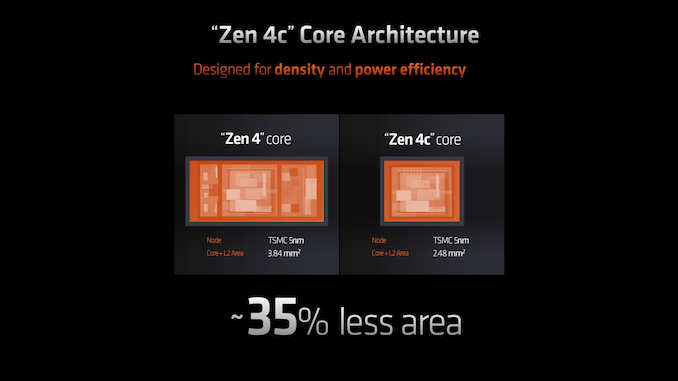
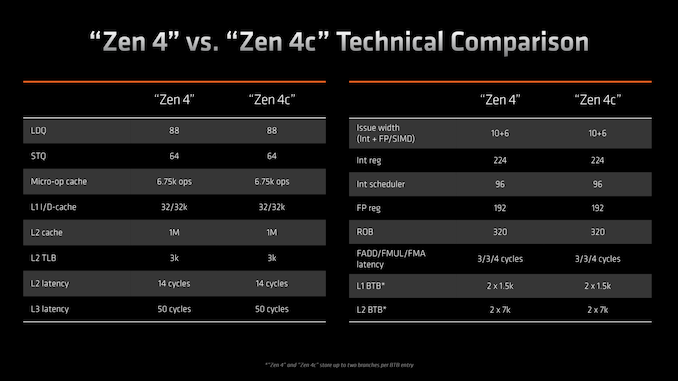
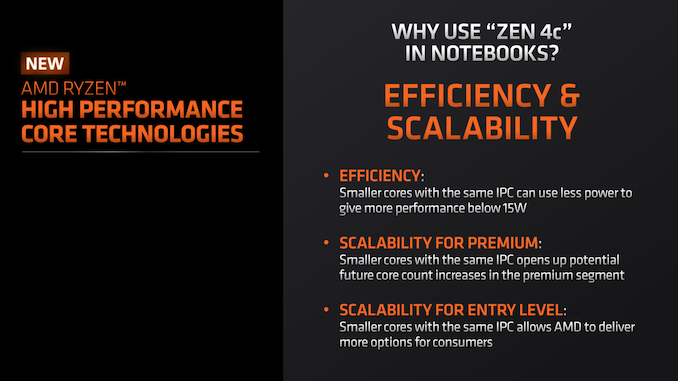
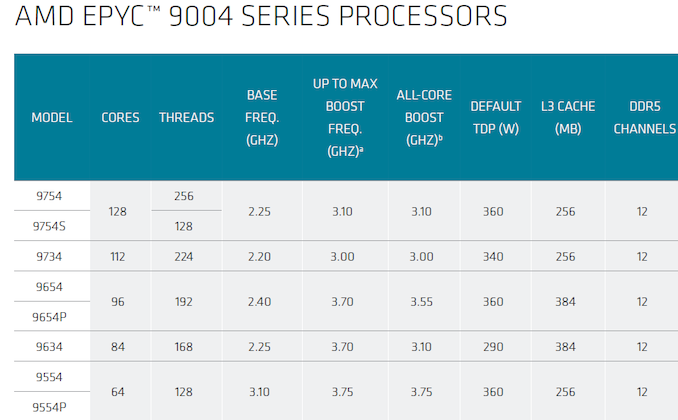
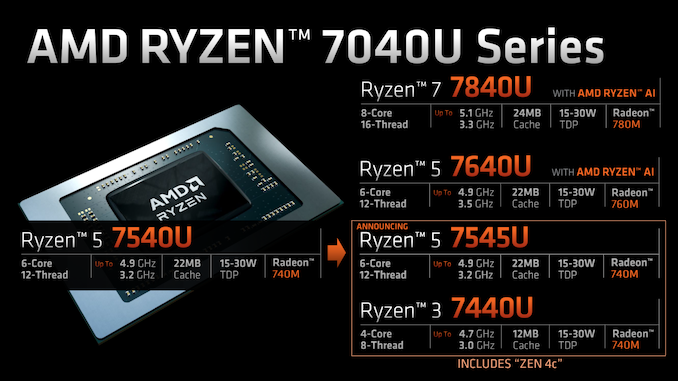
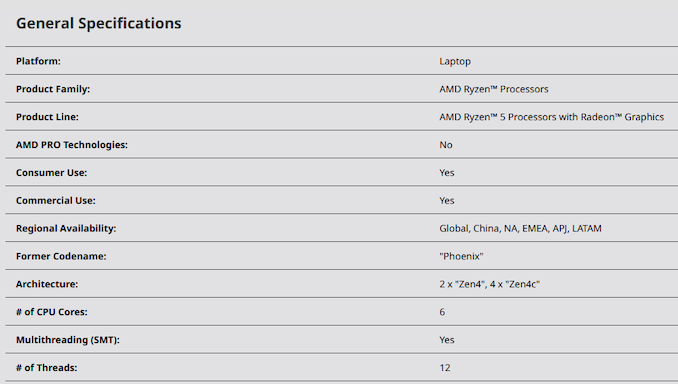
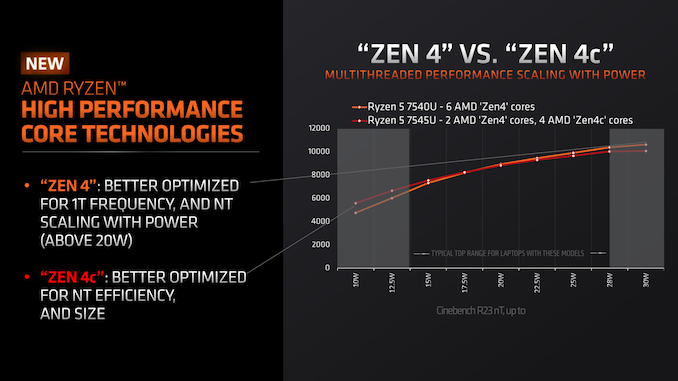














43 Comments
View All Comments
Ryan Smith - Thursday, November 2, 2023 - link
The NPU in Phoenix is a separate functional block. It is not reusing the GPU.As for what libraries are supported under what OSes, I'm afraid I don't have that information handy. I know that Ryzen AI is accessible via ONNX, but I don't have any further details than that.
https://github.com/amd/RyzenAI-SW
systemBuilder33 - Thursday, November 2, 2023 - link
ERROR : "The Chips: Ryzen 5 7545U and Ryzen 3 7440U" section, first table "AMD Ryzen 7040U series"The 7545U with 2+4c Ryzen chips must have a 12MB L3 cache, not 16. That makes sense. The 7640U has 16MB cache. The 7545 changes 4 cores to 'c' cores so it must save at least 4MB of cache. There is no way that the 7545U and 7640U have the same cache size. The whole point of 'c' cores is to save on cache, and if both cores are 16MB cache, that would be stupid.
Ryan Smith - Thursday, November 2, 2023 - link
Hi. The specs in that table are correct. The L3 cache is shared over the entire CCX; it's not a per-core arrangement. Even though AMD has synthesized a CCX with just 6 CPU cores, they put a full 16MB of L3 cache in there.More broadly speaking, Zen 4c in servers exists in part to save on L2 cache. But this isn't true for the mobile parts. The server parts had 2MB of L2 per core with Zen 4, and 1MB of L2 with Zen 4c. But the mobile parts always had 1MB of L2 per core.
garloff - Saturday, November 4, 2023 - link
Ryan: You meant to write L3 cache in the 2nd paragraph rather than L2 cache, right?Ryan Smith - Saturday, November 4, 2023 - link
As odd as it may seem, in this case the answer is no. I do mean L2 cache.Server Zen4c parts have less private L2 cache per core; it's part of how they managed to shave off 35% of the area of a CPU core.
As for L3 cache, AMD's chiplet CCDs have the same 64MB of shared L3 cache each, regardless of the core type used. It just happens to be that with 16 cores per Zen 4c CCD, you have fewer CCDs altogether than with Genoa (8x16 instead of 12x8). Which is moot for mobile, because the mobile CCX designs all are built with 16MB of L3.
FWhitTrampoline - Friday, November 3, 2023 - link
Monolithic APU Tape-outs are Bespoke affairs so can not really be compared to CCD/Chiplet based processors from AMD. And the Die Shots of some Zen-4/Zen-4C based APU designs all show the cores arranged around the same Ring Bus like topology on that monolithic APU die so the L3 is maybe just another stop along that Ring Bus(?) there and all the cores since Zen-3 have a unified L3 cache pool.And even Ryzen 4000 series APUs that had 2, 4 core Zen-2 CCX Units had no need for any IFOP(Infinity Fabric Off Package/Off Die) connectivity as the 2 CCX Units where on the same Monolithic slab of APU silicon so the latency was different and so was the memory access latency different compared to Chiplet based processors that had to go off die to access the memory controller on Zen-2/Later chiplet based processors where the I/O die was separate from the CCD DIE/DIEs.
meacupla - Thursday, November 2, 2023 - link
I think it's good this is only going to be done on the R3 and R5. Those two get to see some of the worst and lowest cost cooling solutions anyone could come up with. Literal penny pinching stuff.haplo602 - Friday, November 3, 2023 - link
So AMD will keep one Zen4 core at least in each chip to skirt the line of dishonest advertising when it comes to maximum clocks (See ? See ? That core CAN hit the clockspeed so all is fine) while not specifying the maximum clock speed for most of the chip ... I expected better ....nandnandnand - Friday, November 3, 2023 - link
"U" parts aren't going to be running all cores at 4.9 GHz in the first place.ballsystemlord - Friday, November 3, 2023 - link
@Ryan , "confirmed" was accidentally typed twice."Diving a bit deeper into the technical specifications for Phoenix 2, AMD has confirmed confirmed ..."